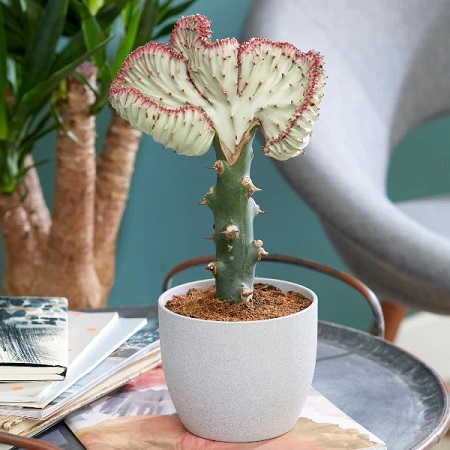
The coral cactus plant is a unique and interesting plant that is a hybrid of two different cacti species: Euphorbia lactea and Euphorbia neriifolia. It is also commonly known as the “candelabra cactus” or “dragon bones plant”.
The coral cactus plant has a striking appearance, with green, cylindrical stems that are densely covered in small, white spines. The stems have irregular, cactus-like branches that resemble coral or a candelabra. The plant is not a true cactus, as it does not have true leaves, but instead has small, green, oval-shaped structures that are modified leaves called “phyllodes”.
The coral cactus plant is a hardy plant that can thrive both indoors and outdoors in warm climates. It prefers bright, indirect light and well-draining soil. It is also drought-tolerant and does not require frequent watering. However, it is important to note that the plant secretes milky sap that can cause skin irritation, so it should be handled with care.
The coral cactus plant is popular for its unique appearance and is often used as a decorative plant in homes and offices. Its striking shape and texture make it a popular addition to succulent gardens, rock gardens, and desert landscapes.
How to Grow Coral Cactus Plant
Growing a coral cactus plant is relatively easy, but it’s important to note that the plant can be toxic if ingested and can cause skin irritation, so be sure to handle it with care. Here are some tips on how to grow a coral cactus plant:
Location
Coral cactus plants prefer bright, indirect sunlight, so choose a location that receives plenty of light but not direct sunlight.
Use Well-Draining Soil
Coral cactus plants prefer well-draining soil that is slightly acidic. You can use a cactus or succulent potting mix or create your own by mixing sand, perlite, and potting soil.
Water Sparingly
Coral cactus plants are drought-tolerant and do not require frequent watering. Water the plant when the soil is completely dry, and be careful not to overwater, as this can cause root rot.
Provide Good Air Circulation
Coral cactus plants prefer good air circulation, so make sure there is space between the branches and the pot and avoid crowding the plant with other plants.
Fertilize Sparingly
Coral cactus plants do not require fertilizer, but you can give them a boost by fertilizing with a balanced houseplant fertilizer once or twice a year.
Propagation
Coral cactus plants can be propagated by stem cuttings. Simply cut off a stem from the parent plant and allow it to dry out for a few days. Then plant the stem in well-draining soil and water sparingly until new growth appears.
6 Fun Facts About the Coral Cactus Plant
The coral cactus plant is also known by several other names, including the dragon bones plant, the milkstripe euphorbia, and the candelabra cactus.
The plant is named for its distinctive coral-like appearance, with irregular, cactus-like branches that resemble coral or a candelabra.
The sap of the coral cactus plant is toxic and can cause skin irritation and other health problems if ingested. It is important to handle the plant with care and avoid contact with the sap.
Despite its toxic properties, the coral cactus plant has a long history of use in traditional medicine. The sap has been used to treat a variety of ailments, including skin conditions, rheumatism, and respiratory problems.
The coral cactus plant is a hardy plant that can thrive in a variety of conditions. It is a popular decorative plant in homes and offices, and its striking shape and texture make it a popular addition to succulent gardens, rock gardens, and desert landscapes.
The plant is easy to propagate from stem cuttings, making it a great choice for gardeners and plant enthusiasts who want to grow their own coral cactus plants.
Related Articles & Free Email Newsletter Sign Up
Aralias Provide an Exotic Look in Many Different Colors
Bromeliads are a Great Plant for Your Greenhouse
The Prickly Pear Cactus Grows Almost Everywhere and is Edible




Comment here